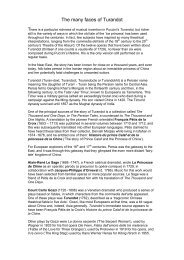NEF-Southampton-Positive-Money-ICB-Submission
NEF-Southampton-Positive-Money-ICB-Submission
NEF-Southampton-Positive-Money-ICB-Submission
You also want an ePaper? Increase the reach of your titles
YUMPU automatically turns print PDFs into web optimized ePapers that Google loves.
Part I: Full-‐reserve banking – a proposal<br />
Brief Overview<br />
There are two core elements of our full reserve proposal:<br />
1.The payments system is separated from risky lending acGvity, so that failure of investments does not<br />
pose any risk to the payments system or other crucial parts of the financial infrastructure.<br />
2.The Monetary Policy CommiOee (MPC), rather than trying to indirectly influence money supply via<br />
the seung of interest rates, can leave interest rates to be set by the market and instead directly<br />
influences the money supply through the creaGon of new money when necessary, within strict<br />
constraints to avoid inflaGonary and deflaGonary pressure. (The MPC could conGnue to use inflaGon<br />
targeGng to guide their decisions).<br />
Step 1: Divorcing the Payments System from Risky Lending AcDvity<br />
We start by classifying all accounts used by bank customers under the new structure into one of two types:<br />
TransacGon Accounts, and Investment Accounts. TransacGon Accounts collecGvely make up the risk-‐free<br />
payments system, while Investment Accounts, rather than holding money, actually represent a risk-‐bearing<br />
investment made by a customer. With the opGon of a risk-‐free method of saving money in TransacGon<br />
Accounts, the Financial Services CompensaGon Scheme guarantee (‘deposit insurance’) can be removed. The<br />
risk of risk-‐bearing Investment Accounts is shared between the bank and the investor/saver, and is not passed<br />
on to the taxpayer through deposit insurance. Further details are given below.<br />
TransacPon Accounts<br />
TransacGon Accounts would replace present-‐day ‘current accounts’ and would provide the full range of<br />
payment services, such as cheques, debit cards, ATM cards, electronic fund transfers, and receiving money<br />
(such as a monthly salary). Holders of TransacGon Accounts will have on-‐demand access to their funds at all<br />
Gmes.<br />
However, a bank will no longer be able to use the money in TransacGon Accounts for making loans or funding<br />
its own investments. The TransacGon Accounts will all be held ‘off the balance sheet’, in fiduciary trust, and<br />
not be considered a liability of the bank – as is the case in custody accounts of custodian banks.<br />
The money paid into TransacGon Accounts will be held in full within an aggregate account at the Bank of<br />
England. This aggregate account, labelled the ‘Customer Funds Account’, would contain risk-‐free, central bank<br />
issued ‘digital’ money. This risk-‐free central bank digital money, when held in a TransacGon Account, will be<br />
owned by the customer.<br />
Because the money placed in TransacGon Accounts would never be lent or invested by the bank and would<br />
technically remain in the Customer Funds Account at the Bank of England, the bank would be able to repay all<br />
its TransacGon Account holders in full, at any Gme, without having any impact on the bank’s overall financial<br />
health. It would be technically impossible for the money to be lost, and a bankrupt bank would sGll be able to<br />
repay all its TransacGon Account holders in full. (See discussion below on winding down a failed bank under<br />
full-‐reserve banking).<br />
Because the bank is unable to use TransacGon Account funds for investment, TransacGon Accounts will not<br />
7



